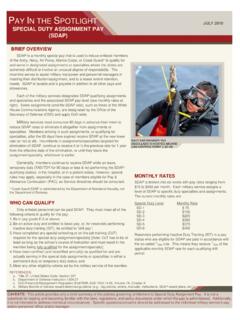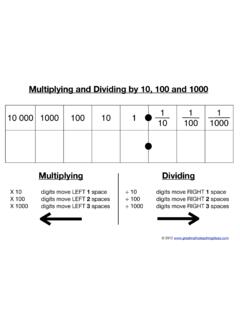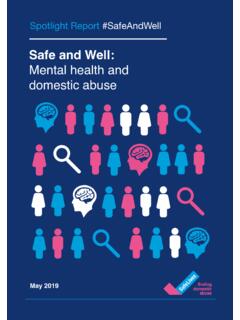Transcription of Self-Employment In The United States - Bureau of Labor …
1 Bureau OF Labor statistics spotlight on statistics MARCH 2016. Self-Employment In The United States Steven F. Hipple and Laurel A. Hammond Since the late 1940s, data on Self-Employment have been collected regularly as part of the Current Population Survey (CPS), a monthly sample survey of about 60,000 households that provides employment and unemployment data for the nation's civilian noninstitutional population ages 16 and older. Since 1967, the official BLS estimates of self- employment have included only the unincorporated self-employed. Although it is possible to identify the incorporated self-employed separately, they are counted as wage and salary workers in the official statistics because, legally, they are employees of their own business.
2 This spotlight on statistics examines recent trends in Self-Employment by various demographic and socioeconomic characteristics, including both the unincorporated and the incorporated self-employed, as well as data on paid employees who work for the self- employed. Page 1. Bureau OF Labor statistics spotlight on statistics 15 million people were self-employed in 2015, or percent of all workers Self-Employment continues to be an important source of jobs in the United States . In 2015, million people, or percent of total employment, were self-employed, including those who had incorporated their businesses and those who had not.
3 Of all the self-employed, million, or about 6 in 10, were unincorporated; the remaining million were incorporated. People who are self-employed typically incorporate their businesses in order to receive traditional benefits of the corporate structure, including limited liability, tax considerations, and enhanced opportunity to raise capital through the sale of stocks and bonds. Page 2. Bureau OF Labor statistics spotlight on statistics The Self-Employment rate has trended down over the past two decades The Self-Employment rate the proportion of total employment made up of self-employed workers has trended down over the past two decades.
4 In 1994, the Self-Employment rate was percent; by 2015, the rate had declined to percent. From 1994 to 2015, the unincorporated Self-Employment rate fell from percent to percent. The long-term decline in unincorporated Self-Employment partially reflects an overall decrease in agricultural employment, where a large share of workers are self-employed. At the same time, there has been a decline in the agricultural Self-Employment rate, which might be due to a decrease in the number of small farms and the emergence of large farming operations. The decline in the unincorporated Self-Employment rate might also reflect a general increase in the likelihood of businesses to incorporate.
5 From 1994 to 1999, the share of total employment made up of the incorporated self- employed ranged from percent to percent. Over the 2000 08 period, the incorporated Self-Employment rate rose from percent to percent. The rate then edged down to percent in 2010 and remained at that level over the 2011 15 period. Page 3. Bureau OF Labor statistics spotlight on statistics 29 States and had Self-Employment rates below the rate; 21 had rates at least as high In 2015, 29 States and the District of Columbia had Self-Employment rates below the rate of percent, and 21. States had rates as least as high. Montana had the highest rate among States , percent, followed by Maine ( percent), Vermont ( percent), and South Dakota ( percent).
6 The lowest rates were in the District of Columbia ( percent), Delaware ( percent), and Alabama ( percent). Among the unincorporated self-employed, Maine ( percent) and Vermont ( percent) had the highest self- employment rates. The lowest unincorporated rates were in the District of Columbia ( percent), Delaware ( percent), Virginia ( percent), and New Jersey ( percent). Among the incorporated self-employed, Montana had the highest Self-Employment rate, percent, followed by Colorado, percent. The lowest incorporated self- employment rates were in Tennessee ( percent) and West Virginia ( percent). Page 4.
7 Bureau OF Labor statistics spotlight on statistics Self-Employment rates are higher for older workers than for younger workers The Self-Employment rate for older workers continued to be higher in 2015 than that for younger workers. The unincorporated Self-Employment rate among workers aged 65 years and older was the highest ( percent) of any age group; in contrast, the rates were much lower for their counterparts aged 16 to 24 ( percent). A possible reason is that younger workers rarely have accumulated the capital and the managerial skills required to start a business, whereas many older workers may be able to acquire these resources through their own efforts or through access to credit.
8 For all age groups, incorporated Self-Employment rates were lower than unincorporated rates; however, incorporated Self-Employment rates also rose with age. Page 5. Bureau OF Labor statistics spotlight on statistics Self-Employment rates for men are higher than those for women Self-Employment rates are higher for men than women. In 2015, percent of men were among the ranks of the unincorporated self-employed, compared with percent of women. The incorporated Self-Employment rate for men was percent, compared with percent for women. Men are more likely than women to work in occupations that have large proportions of self-employed workers for example, in construction occupations and in management occupations.
9 Page 6. Bureau OF Labor statistics spotlight on statistics Self-employed workers can be found at all levels of education Self-employed workers can be found at both ends of the educational attainment spectrum. In 2015, among those aged 25 years and older, unincorporated Self-Employment rates were highest for those with less than a high school diploma and for those with a professional degree ( and percent, respectively) and lowest for individuals with a bachelor's degree or master's degree ( and percent, respectively). Among the incorporated self-employed, Self-Employment rates were highest for those with a professional degree ( percent) and for those with a doctoral degree ( percent).
10 In contrast, the incorporated Self-Employment rate for people with less than a high school diploma was much lower, at percent. Page 7. Bureau OF Labor statistics spotlight on statistics Self-Employment rates are higher for Whites than for Blacks or Hispanics Whites continued to be more likely than Blacks or Hispanics to operate their own businesses. In 2015, the unincorporated Self-Employment rate for Whites was percent while the rates for Blacks and Hispanics were percent and percent, respectively. The rate for Asians was percent. Incorporated Self-Employment rates were highest for Asians and Whites ( percent for both groups).














